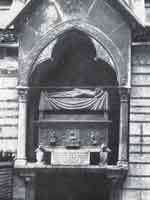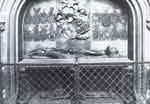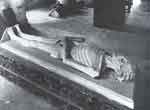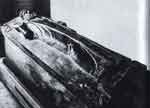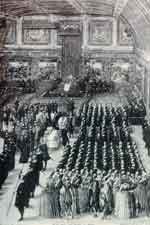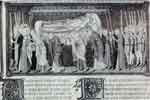|
|
|
|
|
|
|
". the king's body natural was "neither divided by itself nor distinct from his office or the royal Dignity", but that they were a Body natural and a Body politic together indivisible; and [that] these two Bodies are incorporated in one Person, and make one Body and not divers, that is, the Body corporate in the Body natural, et e contra the Body natural in the Body corporate."
Kantorowitz, p.438.
|
|
|
"There is in the king not a Body natural alone, nor a Body politic alone, but a body natural and politic together: corpus corporatum in corpore naturali, et corpus naturale in corpore corporato."
Sir Francis Bacon, p. 667.
|
|
Tomb of Robert Anjou. S. Chiara, Naples.
In.: Erwin Panofsky, Tomb Sculpture. Ed. by H. W. Janson. Phaidon Press Ltd. London, 1992. Figure 398.
|
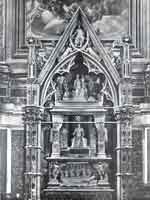 |
 |
|
|
|
|
"It is true that the king in genere dieth not, but, no question, in individuo, he dieth"
Plowden, p. 177.
|
|
Effigy of Jean Cardinal de Lagrange en transi (died 1402).
Calvet Museum, Avignon. Panofsky, Tomb Scultpure, figure 263. |
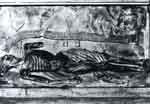 |
 |
|
Jacopo Bellini: Drawing of the Imaginary Tomb of a Professor.
Louvre, Paris. Panofsky, Tomb Scultpure, figure 268. |
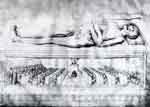 |
 |
|
|
"... the king has in him two Bodies, viz., a Body natural, and a Body politic . His Body natural is a Body mortal, subject to all Infirmities that come by Nature or Accident, to the Imbecility or old Age, and to the like Defects that happen to the natural Bodies of other People. But his Body politic is a Body that cannot be seen or handled, consisting of Policy and Government, and constituted for the Direction of the People, and the management of the public weal, and this body is utterly void of Infancy, and old Age, and other natural Defects and Imbecilities, which the Body natural is subject to, and for this Cause, what the King does in his Body politic, cannot be invalidated or frustrated by any Disability in his natural Body."
Plowden, p. 212.a.
|
|
|
|
Germain Pilon: Tomb of Valentine Balbiani.
Louvre, Paris. Panofsky, Tomb Scultpure, figure 364. |
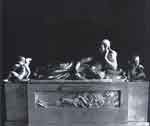 |
 |
|
|
"The king has two Capacities, for he has two Bodies, the one whereof is a Body natural, consisting of natural Members as every other Man has, and in this he is subject to Passions and Death as other Men are; the other is a Body politic, and the Members thereof are his Subjects, and he and his Subjects together compose the Corporation, and he is incorporated with them, and they with him, and he is the Head, and they are the Members, and he has the sole Government of them; and this Body is not subject to Passions as the other is, nor to Death, for as to this Body the King never dies, and his natural Death is not called in our Law (as Hasper said) the Death of the King, but the Demise of the King, not signifying by the Word (Demise) that the Body politic of the King is dead, but that there is a Separation of the two Bodies, and that the Body politic is transferred and conveyed over from the Body natural now dead, or now removed from the Dignity royal, to another Body natural."
Plowden, 233. a.
|
|
Jacques Dubroeucq: Tomb of Bishop Eustache de Croy (died 1538).
Notre Dame, St-Omer. Panofsky, Tomb Scultpure, figure 356. |
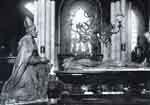 |
 |
|
Tomb of John Fitzalan (died 1435).
Church, Aroundel, Sussex. Panofsky, Tomb Scultpure, figure 262. |
 |
 |
|
|
Sources:
- Sir Francis Bacon, Post Nati.
- Ernst H. Kantorowitz, The King's Two Bodies - A Study in Medieval Political Theology. Princeton University Press, Princeton, New Jersey 1957.
- Edmund Plowden, Commentaries or Reports. London, 1816 (Originally 1571).
|
|
|
|
|
"Le portrait de César, c'est César"
Arnauld - Nicole
|
|
Tomb of Bishop Richard Fleming (died 1431).
Chatedral, Lincoln. Panofsky, Tomb Scultpure, figure 261. |
 |
 |
|
|
"...we may recall the forty days elapsing between the death and the funeral ceremonies of the ancient kings of France, during which period food was served to an effigy representing the deceased."
Hertz, p. 133.
|
|
Page (fols. 32v, 87) from MS. Add.
37049, British Museum, London. Panofsky, Tomb Scultpure, figure 266/a. |
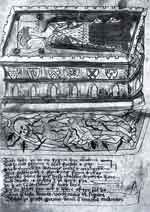 |
 |
|
|
"...Alberti, in the second book of his treatise On Painting, was already writing that "painting is contains a divine force which not only makes absent men present, as friendship is said to do, but moreover makes the dead seem almost alive."
Marin, p. 5.
|
|
Girolamo della Robbia: Catherine de Médicis en transi.
Louvre, Paris. Panofsky, Tomb Scultpure, figure 357. |
 |
 |
|
|
"...The king is only true king, that is, monarch, in images. They are his real presence."
Marin, p. 5.
|
|
|
|
|
"...the king has only one body left, but this sole body, in truth, unifies three, a physical historical body, a juridico-political body, and a semiotic sacramental body, the sacramental body, the "portrait," operating the exchange without remainder (or attempting to eliminate all remainder) between the historical and political bodies."
Kantorowitz, p. 421.
|
|
|
"...the first effect of representation in general: to do as if the other, the absent one, were here and the same; not presence but effect of presence."
Marin, p. 7.
|
|
|
|
|
"...enclosed in the coffin . there rested the corpse of the king, his mortal and normally visible - though now invisible - body natural; whereas his normally invisible body politic was on this occasion visibly displayed by the effigy in its pompous regalia: a persona ficta - the effigy - impersonating a persona ficta - the Dignitas."
Kantorovicz, p. 421.
|
|
Page (fols. 32v, 87) from MS. Add.
37049, British Museum, London. Panofsky, Tomb Scultpure, figure 266/b. |
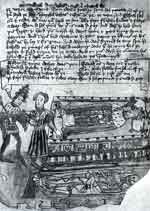 |
 |
|
|
"And in this state the effigy remained for eleven days. And it is to be understood and known that during the time the body was in the chamber next to the great hall, as well as while the effigy was in that hall, the forms and fashions of service were observed and kept just as was customary during the lifetime of the king. The table being set by the officers of the commissary; the service carried by the gentlemen servants, the bread-carrier, the cupbearer and the carver, with the usher marching before them and followed by the officers of the cupboard, who spread the table with the reverences and samplings that were customarily made. After the bread was broken and prepared, the meat and other courses were brought in by an usher, steward, bread-carrier, pages of the chamber, squire of the cuisine and garde-vaisselle. The napkin was presented by said steward to the most dignified person present, to wipe the hands of the Seigneur [the king]. The table was blessed by a Cardinal; the basins of water for washing the hands presented at the chair of the Seigneur, as if he had been living, and seated in it. The three courses of the meal were carried out with the same forms, ceremonies and samplings as they were wont to be during the life of the Seigneur, without forgetting those of the wine, with the presentation of the cup at the places and hours that the Seigneur had been accustomed to drink, two times at each of his meals."
Giesey, p. 5.
|
|
|
|
|
"On the 18th of May, already seven weeks since the death of Francis I, Henry II came to St.-Cloud to asperse the body of his father. This ceremony marked the only time that the new king made an official public appearance from the moment of his predecessor's death until his own coronation. Even to call this ceremonial "official" is misleading. Henry II same not as Roi de France but as fils de Francois; not the dignity of the royal majesty but the devoirs of filial piety motivated him. There were serious problems of punctilio. For one thing, Henry could not have appeared while the effigy was on display, else there would have occurred the simultaneous exposure to view of two kings of France - an impossible situation. So Henry waited until the effigy had been removed and the salle d'honneur converted into a salle de deuil."
Giesey, p. 7.
|
|
|
|
|
"Vieilleville himself, together with the new royal favorite, the young Marshal Saint-André, viewed the procession secretly, along with Henry II, from the coign of vantage of a house on rue St. Jacques along the route of the convoy. No doubt Henry, forbidden by tradition to attend the funeral of his predecessor, did not want to miss the spectacle which he had gone to so much pains and expense to arrange; nonetheless he warned his companions that they must not make any reverence or respect toward him, for fear of disclosing his presence, since his attendance was a "travesty"."
Giesey, p.11.
|
|
| The dead mask of King Francois I. |
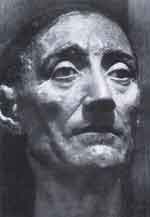 |
 |
|
|
"Francis I's funeral acquired dramatic tension by repeated disjunction of the encoffined corpse and the lifelike effigy. Had there been displayed, instead of an effigy, the embalmed body of the king, the striking distinction between the mortal remains and the immortal dignity would have been blurred: after all, the corpse could not have impersonated the living majesty as unambiguously as the true-to-life effigy."
Giesey, p. 11.
Sources:
- Antoine Arnauld, Pierre Nicole, La Logique, ou L'Art de penser. 5th.ed.Paris,1683.
- Ralph E. Giesey, The Royal Funeral Ceremony in Renaissance France. Libraire E. Droz, Geneva, 1960.
- Ernst H. Kantorowitz, The King's Two Bodies - A Study in Medieval Political Theology. Princeton University Press, Princeton, New Jersey 1957.
- Louis Marin, Portrait of the King. University of Minnesota Press, Minneapolis 1988.
|
|
|
|

